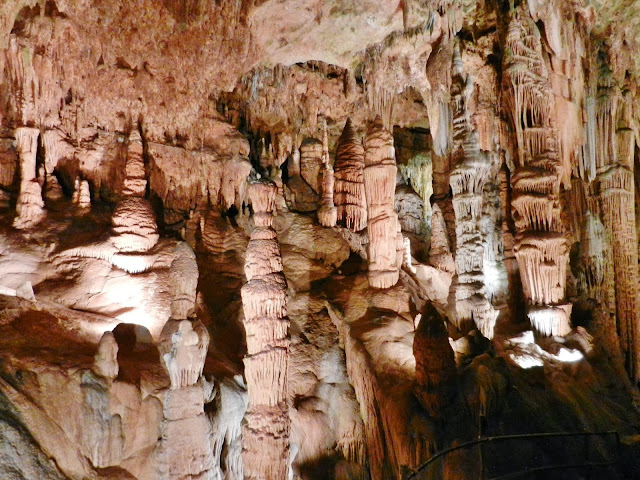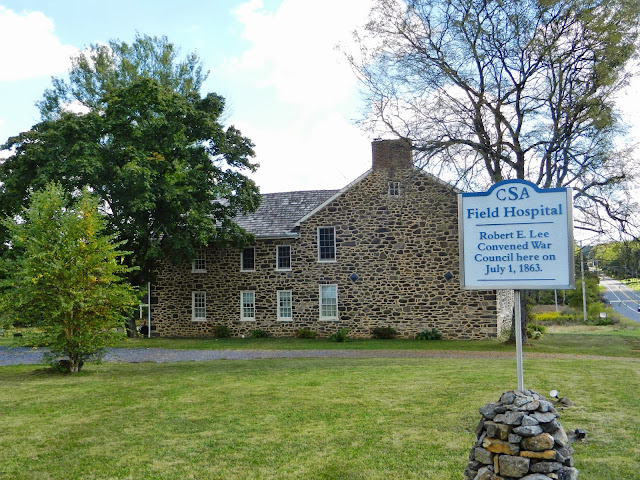Thomas Jefferson has long been one of my heroes. He wasn't a perfect man, but he was awesome for his time.
Here I am with TJ. He is tall. And he is aloof.

We had stopped in Byoona Vista, as I mentioned earlier, to visit our old friends Etta and John. We drove down to Monticello on Tuesday morning. Luckily, the house is owned by the Thomas Jefferson Foundation (a mighty good concept, if you ask me) and not the Federal Government, as the government shut-down that morning prevented us from visiting Appomattox.
Here we are. I think I am telling the volunteer how to work the camera.
I was kind of "ho hum" about the whole thing, although I didn't let on, because old houses are only so thrilling, in my book. As it turned out, it was a fascinating look into the brain of old TJ.
Take, for instance, the entrance to the home. Note the compass in the ceiling and the great clock on the wall, which was designed by TJ. It has two faces, one facing the fields outside, thus serving the field workers as well as the inhabitants of the house. It struck a gong on the hour and doesn't have minute hands. Each section between the numbers is divided into quarters and then into five-minute increments.
The hall served as a reception room and waiting room for visitors, as well as a museum of American natural history, western civilization, and American Indian cultures.
The house is full of Jefferson's innovations, but photos are not allowed. I did, however, sneak this one of the kitchen, because I do love a well-stocked kitchen.
Houses were not commonly built so high up on a hill in Jefferson's time, but he loved the view and figured out a way to do it. You can understand why he craved the peace and beauty of this view.
There is a dig in progress in the slave quarters. It looked like a fun job on this sunny afternoon.
We walked along the gardens on the way back to the bus and I was quite taken with these snake-like squash.
And I may or may not have filched a few corn seeds along the way.
The front of the house, which looks almost identical to the back.
I could go on for hours about Jefferson and all of his cleverness in the house and the gardens, but I am feeling lazy, so you will have to visit there yourself.
We couldn't resist a photo in the magnificent linden tree at the entrance to Monticello. I believe this was a young tree in Jefferson's time.
We stopped off at the graveyard on the way down to the visitors' center. A couple of gravestones caught my eye.
I want this on our stone when we die.
And this one made me a little sad.
We stopped at Michie Tavern for some lunch/dinner. It was very delicious and strangely served as a buffet for the first helping, but then you had to tell a waiter when you wanted seconds of anything and they were supposed to bring it to you. Not very satisfactory, because you can see what happened when I asked the waiter for some more cornbread, specifying that I wanted a middle piece, not the ends.
I tried to hail him to see why he brought me some dried-out old ends, when we saw him out of the window, high-tailing it down a path towards the shops. I had to find someone else to get me some more cornbread, and she was a bit indignant and defensive of the original waiter. When he came back, he toddled over to our table and apologized, saying that he thought I asked for the ends, and then giving us a sad story about having to buy some new shirts for his job and how expensive they were.
Um, don't want to hear, closing my ears now!
We drove back to Byoona Vista and said our farewell to John and Etta, and headed for the Natural Bridge, which was high on my list of priorities to visit.
We arrived at five o'clock, only to find that the attractions were closed and the only thing we could visit was the bridge. We were okay with that, so here we are.
In 1774, Jefferson bought 157 acres (including the natural bridge) from King George of England for twenty shillings. I heard somewhere that it equals about $1,200 in today's currency. Quite a steal. But if you think about it, he probably should have waited a couple more years and it would have been his for nothing!
The bridge is massive, but you don't get much of a feel for it until the next photo.
There is teeny-tiny Jeff, standing at the bottom.
Light was fading fast, but I wanted to stay until seven o'clock to see the Drama of Creation, a light show with music and the biblical account of the creation that was inaugurated by Calvin Coolidge in 1927. After all, I said to Jeff, it's unlikely that we will ever get back this way again.
To pass the time, we walked along the Cedar Creek Trail to Lace Falls in the rapidly waning light.
The base of the creek is unusual, consisting of rippled and layered stone.
Lace Falls.
We were underwhelmed.
We arrived back at the seating area just before it got too dark to see, and still had half-an-hour to wait. The show was quite spectacular (have I been using that word a lot lately?) and I am glad we waited to see it. The half-hour show consists of narration, accompanied by a light show and some of my favourite classical music, ending with (I am pretty sure) the Mormon Tabernacle Choir singing God Be With You Till We Meet Again.
We still had four hours to drive to Annie's house that night, so we listened to country music on the radio and drove and drove and drove until we arrived at her house at 1:30 am.
Just in time to catch a few hours sleep and babysit two of the grandkids the next morning.
Warning: The next post will consist of gazillions of cute grandchildren photos.




















































